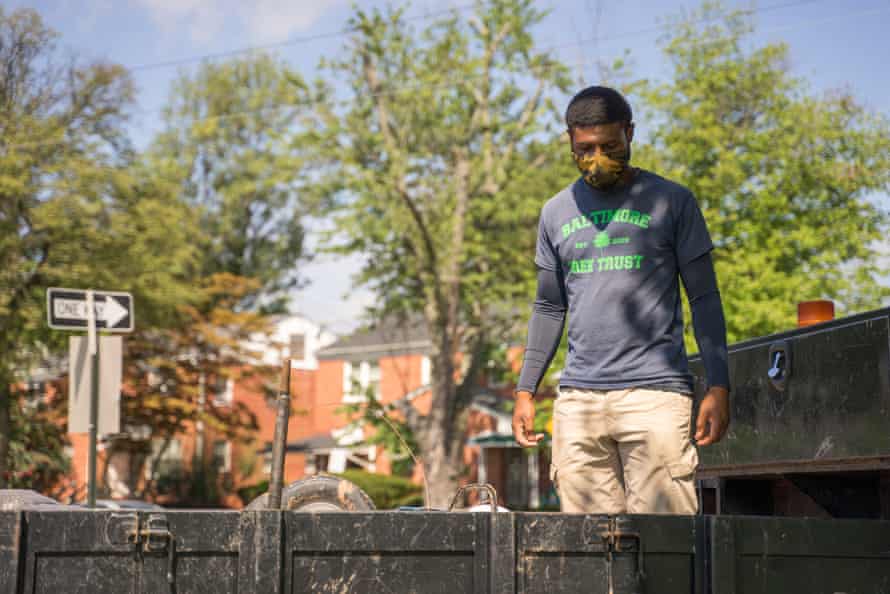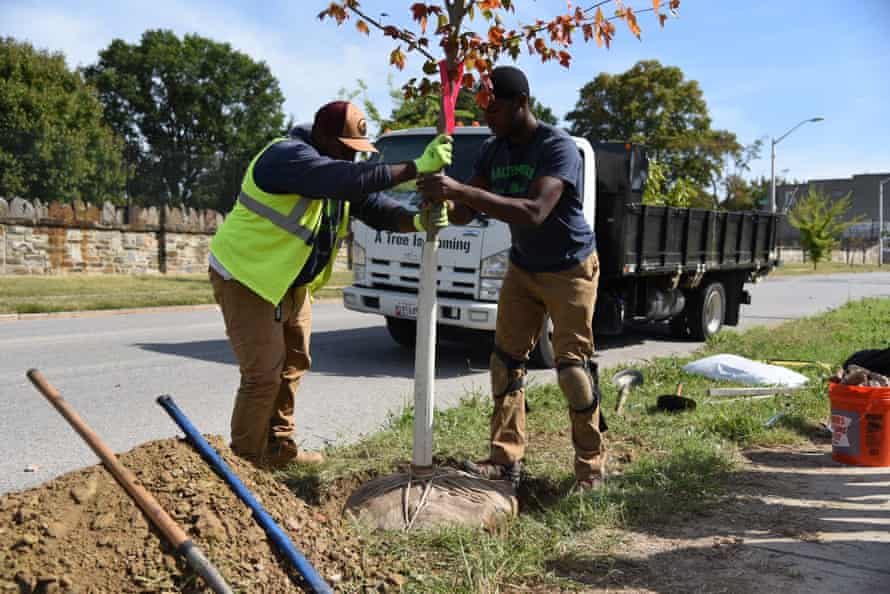In 2005, when Celena Owens purchased an investment property in the up-and-coming East Baltimore neighborhood of Oliver, it was supposed to make her life better. But three years later, the housing market crashed, neighborhood renewal stalled, and the home that was going to be a rental became her full-time residence. Owens fell into what she describes as a “major depressive episode” that would last for the better part of a decade.
That’s when Owens, an IT developer for the state of Maryland, began to notice a pattern. During her workdays in the leafy suburbs of a nearby county, her mood would lift. “Even though I was still dealing with stuff, I felt a sense of calm, of comfort,” she remembers. On the commute back to the nearly treeless neighborhood she called home, that feeling would evaporate. “The closer I got to my house, the more depressed I would feel,” she says. “It was just this overwhelming sense of heaviness.”
Owens’s experience demonstrates the very real influence of tree inequity. In many cities, a map of urban tree cover reflects the geography of race and income, just as it does in Oliver, where 97% of residents are African American. This holds true across Baltimore, which still bears the scars of redlining, policies that denied mortgages and other financial services to entire communities of color. Black residents were essentially barred from purchasing homes in so-called greenlined neighborhoods, forced instead to choose among inner-city redlined areas.

Today, according to the US Forest Service, previously redlined areas have an average of 23% tree cover, while once-greenlined neighborhoods, living up to their old label, have an average of 43% tree cover. When Owens moved to Oliver, only about 10% of the neighborhood was tree-covered, according to Justin Bowers, associate director of the Baltimore Tree Trust, an organization that works to restore the city’s urban canopy. In a dense neighborhood without lawns, this meant a stark lack of green space.
The adverse effects of treeless neighborhoods are well-known and many. Bowers says that summer days in East Baltimore neighborhoods can be four to 16 degrees hotter than other parts of the city. In addition to heat-related illnesses, residents who lack tree cover consume more energy to stay cool, endure poorer air quality and – like Owens – report diminished mental health, he explains.
Trees have long been suspected to have a positive effect on city-dwellers’ overall happiness. But for many years, the correlation between urban trees and mental health remained difficult to prove.
Researchers in Germany have now provided concrete evidence of the link between trees and mental health, by studying the correlation between prescription antidepressants and tree cover across a range of neighborhoods. This allowed researchers to avoid the shortcomings of previous studies, which have taken various approaches to the question of: how do you define and measure mental health?
Even if a group of scientists chose to zoom in on a single mental illness, such as depression, there are still “a variety of self-reported questionnaires one can use to measure it”, says Melissa Marselle, an environmental psychologist and lecturer at De Montfort University who led the Germany study. “This made comparing the results [across studies] difficult, as each questionnaire may be measuring depression differently.”

Past studies also failed to determine how close a tree needs to be to someone’s home to make a difference. Does simply looking out the window and seeing foliage have the same effect on mental health as visiting a city park? No one could say for sure.
To isolate the relationship between everyday green space and mental health, Marselle and a team of interdisciplinary researchers from the Helmholtz Centre for Environmental Research, the German Centre for Integrative Biodiversity Research and Leipzig University designed a study to figure out how the number, type and proximity of trees correlated to the number of antidepressants prescribed in a given neighborhood.
The researchers analyzed data collected from 10,000 Leipzig residents during the University of Leipzig’s Life-Adult Health Study, an exhaustive study that took place between 2011 and 2014 in which participants reported a wide array of health metrics, including their prescriptions. By combining that data with the number and species of street trees throughout the city, researchers were able to demonstrate in more material terms than ever before the correlation between trees and mental wellness.
They found that, regardless of species, more trees within 100 meters from the home was associated with a reduced risk of antidepressant use. “This everyday contact with nearby nature – either through a window view at the home or on the street – has been shown to be beneficial for mental health and wellbeing,” the researchers reported.
The association was especially pronounced in residents with low socioeconomic status. “This is important because those from social deprived groups are most likely to be prescribed antidepressants,” says Marselle.
Though the study has several limitations (some individuals with depression are not prescribed medication as part of their treatment; some don’t have access to treatment at all), it can serve as an important directive to urban planners. “While planning, guidance for urban green space is mostly based on intentional, purposeful visits for recreation,” the researchers wrote, “we suggest that such ‘unintentional’ everyday contact may reach more people and that such easily accessible urban green space can contribute to public health.”
This study comes on the heels of another that found that during Covid-19 lockdowns, people who could see trees and greenery outside their window reported lower rates of anxiety and depression, further demonstrating the importance of trees near the home.

In 2012, a non-profit called ReBUILD Metro began investing in Celena Owens’s neighborhood, working with residents to remediate abandoned properties. Meanwhile, Justin Bowers says Baltimore Tree Trust “completely planted out”, the nine neighborhoods that make up East Baltimore.
“It definitely feels different,” Owens says. “It’s cooler on a physical level, obviously, but also on an aesthetic level. It creates a whole different vibe on the block and in the community in general.”
By 2015, her depression had abated. Today, she’s an outspoken community leader, spearheading efforts to build more parks and playgrounds in Oliver. She’s also dedicated to raising awareness about the benefits of street trees among her neighbors who she says sometimes object to tree plantings over concerns about weeds in the summer and leaves in the fall.
Owens may be busy creating change in her neighborhood, but she’s not quite done with her own space. Soon, she hopes to dig up the small concrete patio behind her rowhouse and “put in a nice little tree”.
This content was originally published here.
